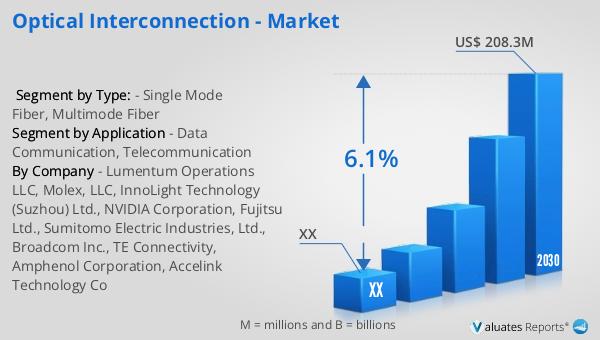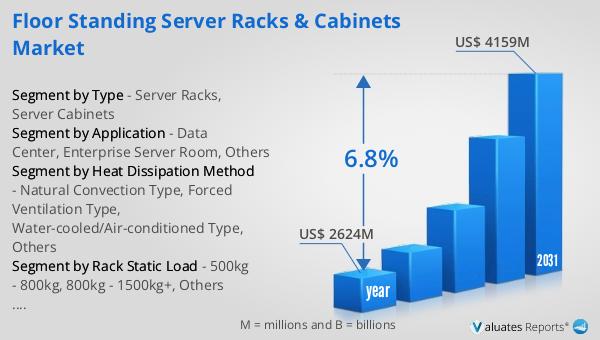What is Optical Interconnection - Global Market?
Optical interconnection refers to the use of optical fibers and related technologies to connect various components within a network, enabling the transmission of data at high speeds and over long distances. This technology is crucial in modern communication systems as it allows for the efficient transfer of large volumes of data with minimal loss and interference. The global market for optical interconnection is driven by the increasing demand for high-speed internet and the growing need for data centers and cloud computing services. As businesses and consumers continue to rely on digital platforms for communication, entertainment, and commerce, the demand for robust and efficient data transmission solutions is expected to rise. Optical interconnection technologies offer several advantages over traditional copper-based connections, including higher bandwidth, lower latency, and greater reliability. These benefits make optical interconnection an attractive option for telecommunications companies, internet service providers, and enterprises looking to enhance their network infrastructure. As a result, the global market for optical interconnection is poised for significant growth in the coming years, driven by advancements in technology and the increasing adoption of digital services worldwide.

Single Mode Fiber, Multimode Fiber in the Optical Interconnection - Global Market:
Single-mode fiber and multimode fiber are two types of optical fibers used in optical interconnection, each with distinct characteristics and applications. Single-mode fiber is designed to carry light directly down the fiber with minimal reflection, allowing it to transmit data over long distances with high precision and low signal loss. This makes it ideal for long-haul telecommunications and high-speed data networks, where maintaining signal integrity over vast distances is crucial. Single-mode fibers have a smaller core diameter, typically around 8 to 10 micrometers, which allows only one mode of light to propagate. This design minimizes dispersion and attenuation, making single-mode fibers suitable for applications requiring high bandwidth and long-distance transmission, such as intercontinental communications and large-scale data centers. On the other hand, multimode fiber has a larger core diameter, usually ranging from 50 to 62.5 micrometers, which allows multiple modes of light to propagate simultaneously. This characteristic makes multimode fiber suitable for shorter distance applications, such as local area networks (LANs) and data centers, where high bandwidth is required over relatively short distances. Multimode fibers are generally more cost-effective than single-mode fibers for these applications due to their simpler design and lower installation costs. However, they are more susceptible to modal dispersion, which can limit their effectiveness over longer distances. In the context of the global optical interconnection market, both single-mode and multimode fibers play crucial roles in meeting the diverse needs of different industries. As the demand for high-speed data transmission continues to grow, the choice between single-mode and multimode fiber will depend on factors such as distance, bandwidth requirements, and cost considerations. For instance, telecommunications companies may opt for single-mode fibers for long-distance communication links, while enterprises with extensive local networks may prefer multimode fibers for their cost-effectiveness and ease of installation. Additionally, advancements in fiber optic technology, such as the development of bend-insensitive fibers and improved manufacturing techniques, are enhancing the performance and reliability of both single-mode and multimode fibers. These innovations are expected to further drive the adoption of optical interconnection solutions across various sectors, including telecommunications, data centers, and enterprise networks. As the global market for optical interconnection continues to evolve, the interplay between single-mode and multimode fibers will remain a key factor in shaping the future of data transmission technologies.
Data Communication, Telecommunication in the Optical Interconnection - Global Market:
Optical interconnection plays a vital role in data communication and telecommunication, providing the backbone for high-speed data transfer and reliable network connectivity. In data communication, optical interconnection is essential for linking various components within data centers, enabling the efficient transfer of large volumes of data between servers, storage devices, and networking equipment. As data centers continue to expand to accommodate the growing demand for cloud computing and big data analytics, the need for high-performance interconnection solutions becomes increasingly critical. Optical fibers offer the bandwidth and speed necessary to support these data-intensive applications, ensuring seamless communication between different parts of the data center. Moreover, optical interconnection reduces latency and minimizes signal loss, enhancing the overall performance and reliability of data communication networks. In the realm of telecommunication, optical interconnection is fundamental to the operation of modern communication networks, facilitating the transmission of voice, video, and data over long distances. Telecommunications companies rely on optical fibers to connect central offices, cell towers, and customer premises, providing high-speed internet and telephony services to millions of users worldwide. The use of optical interconnection in telecommunication networks enables the delivery of high-quality services with minimal interference and signal degradation, ensuring a superior user experience. Additionally, optical interconnection supports the deployment of advanced technologies such as 5G and fiber-to-the-home (FTTH), which require robust and reliable network infrastructure to deliver ultra-fast internet speeds and enhanced connectivity. As the demand for high-speed internet and advanced communication services continues to grow, the role of optical interconnection in data communication and telecommunication will become increasingly important. The global market for optical interconnection is expected to expand as more industries and consumers adopt digital technologies, driving the need for efficient and reliable data transmission solutions. By leveraging the advantages of optical interconnection, businesses and service providers can enhance their network capabilities, improve service quality, and meet the evolving needs of their customers.
Optical Interconnection - Global Market Outlook:
The global optical interconnection market was valued at approximately $135 million in 2023, with projections indicating a growth to around $208.3 million by 2030. This growth represents a compound annual growth rate (CAGR) of 6.1% over the forecast period from 2024 to 2030. The North American segment of this market was also valued at a significant amount in 2023, with expectations of reaching a higher value by 2030, although specific figures for this region were not provided. The anticipated growth in the optical interconnection market is driven by the increasing demand for high-speed data transmission and the expansion of data centers and telecommunication networks. As digital transformation continues to accelerate across various industries, the need for efficient and reliable optical interconnection solutions is expected to rise. This growth is further supported by advancements in optical fiber technology and the increasing adoption of cloud computing and big data analytics. The optical interconnection market is poised for significant expansion as businesses and consumers continue to rely on digital platforms for communication, entertainment, and commerce. By investing in optical interconnection technologies, companies can enhance their network infrastructure, improve service quality, and meet the evolving needs of their customers in an increasingly digital world.
| Report Metric | Details |
| Report Name | Optical Interconnection - Market |
| Forecasted market size in 2030 | US$ 208.3 million |
| CAGR | 6.1% |
| Forecasted years | 2024 - 2030 |
| Segment by Type: |
|
| Segment by Application |
|
| By Region |
|
| By Company | Lumentum Operations LLC, Molex, LLC, InnoLight Technology (Suzhou) Ltd., NVIDIA Corporation, Fujitsu Ltd., Sumitomo Electric Industries, Ltd., Broadcom Inc., TE Connectivity, Amphenol Corporation, Accelink Technology Co |
| Forecast units | USD million in value |
| Report coverage | Revenue and volume forecast, company share, competitive landscape, growth factors and trends |
